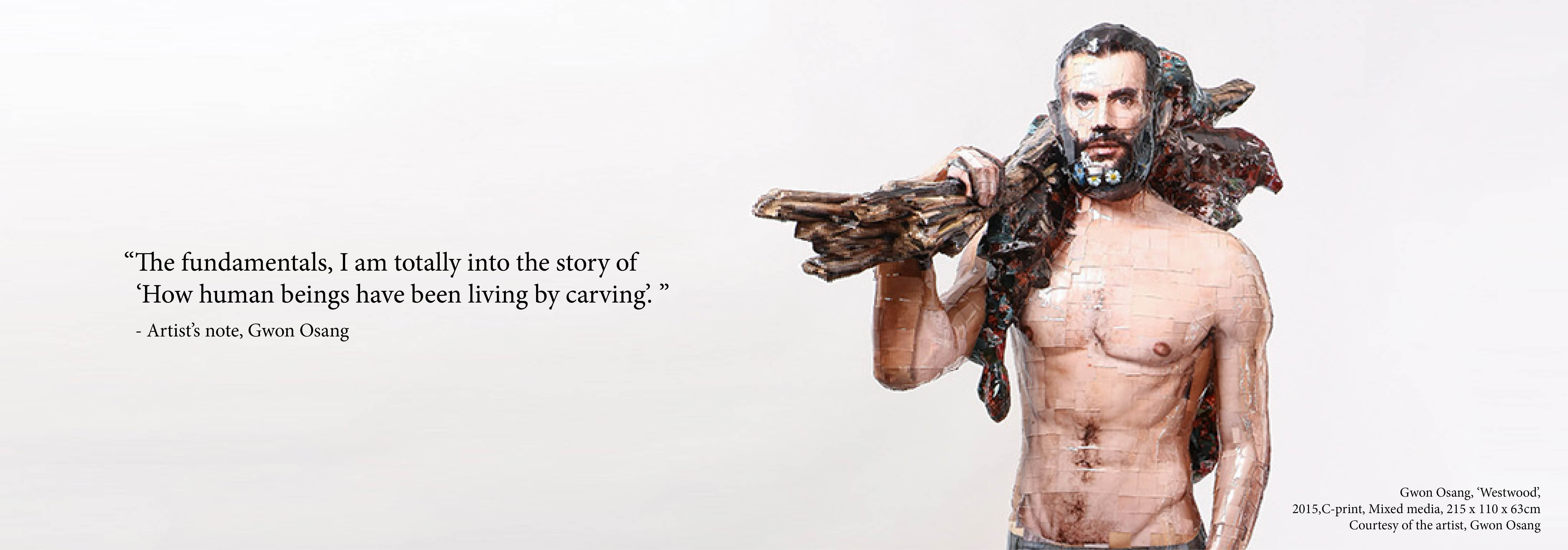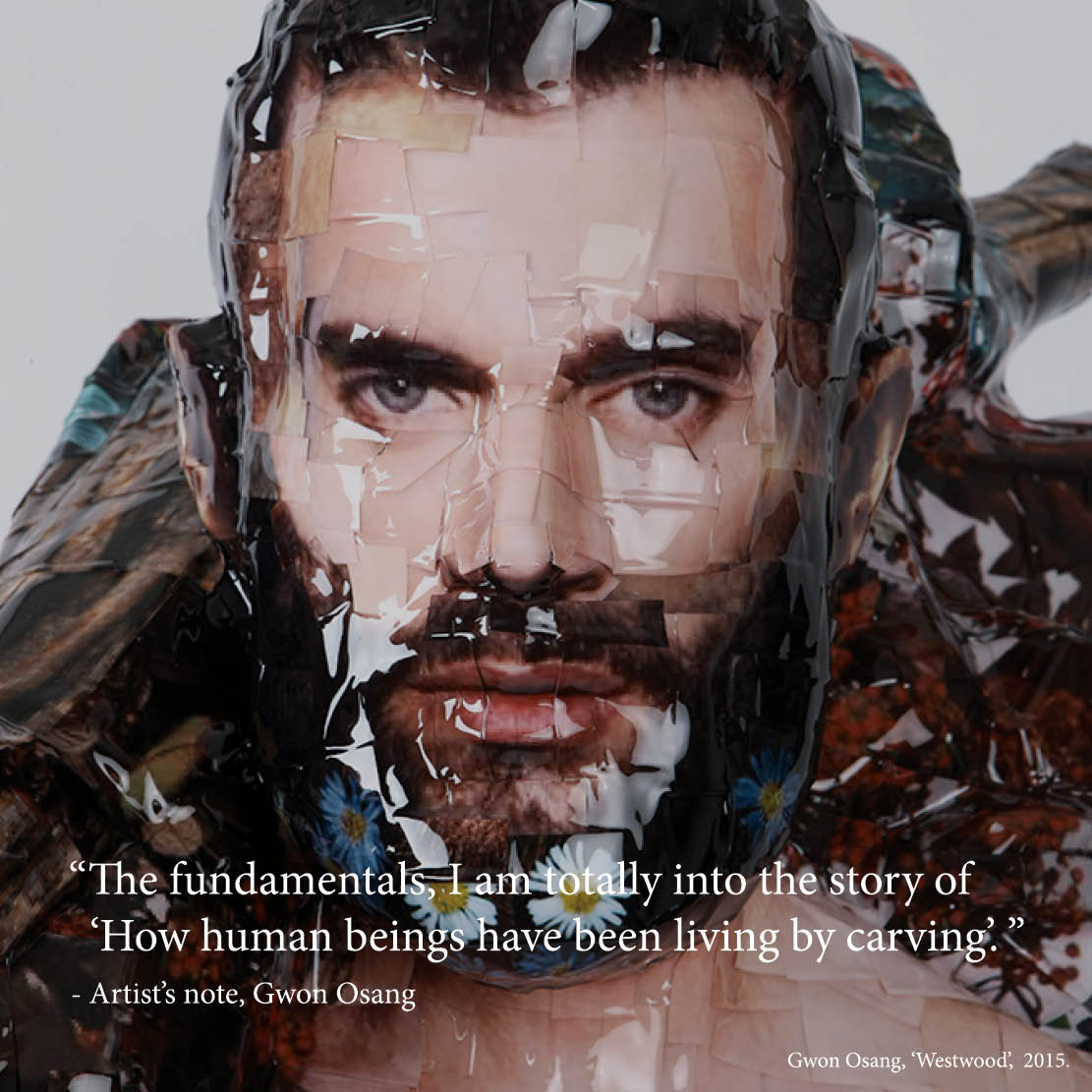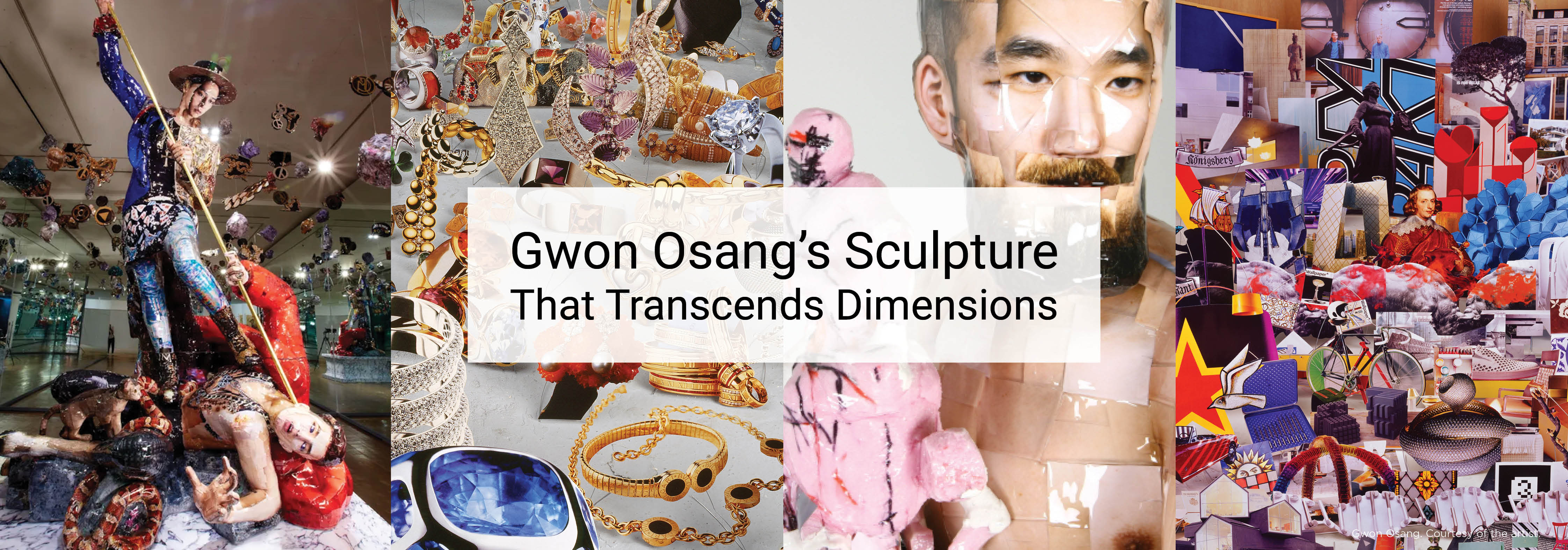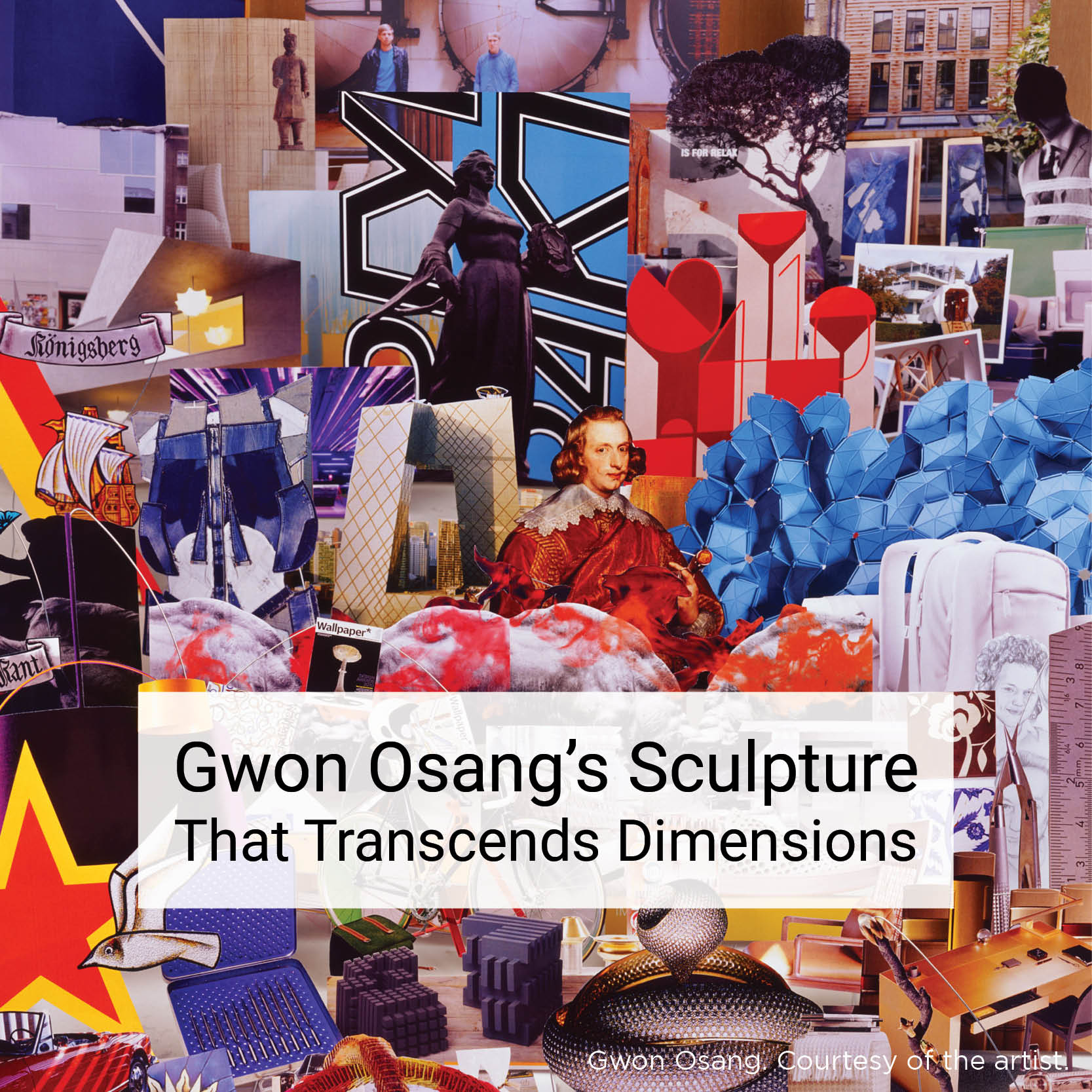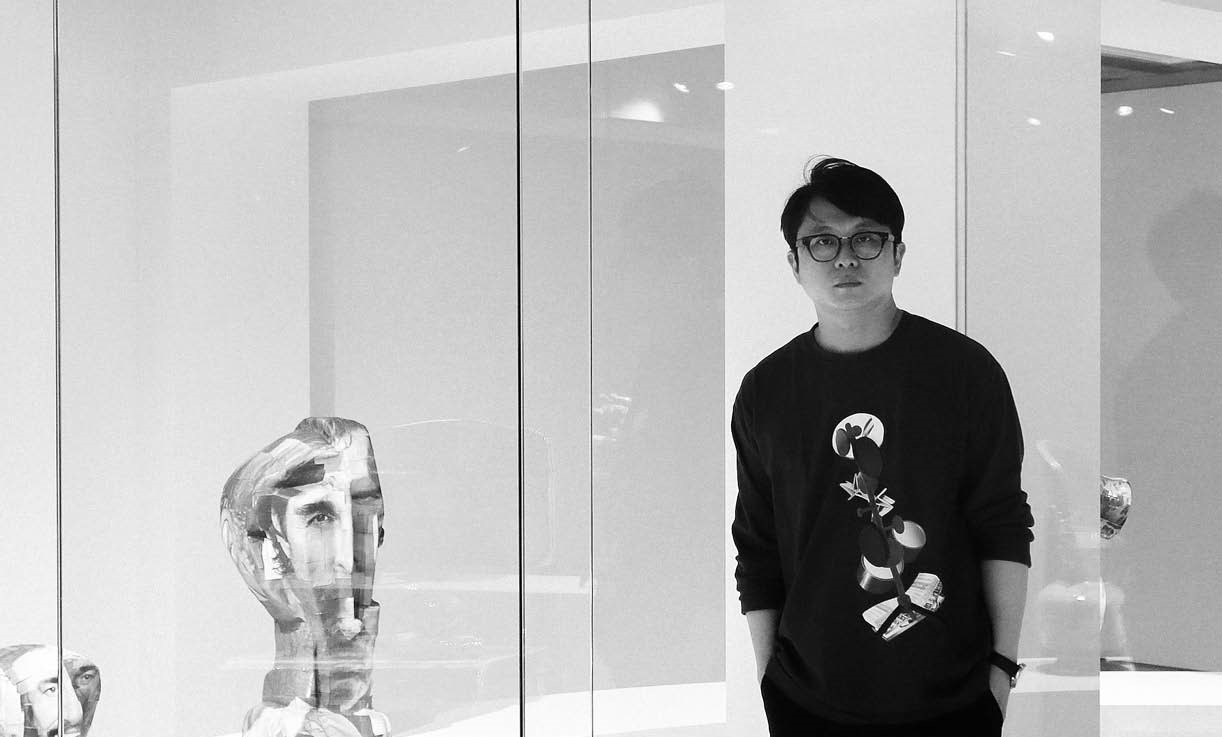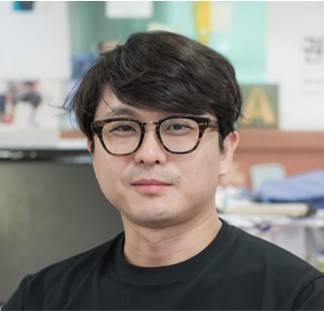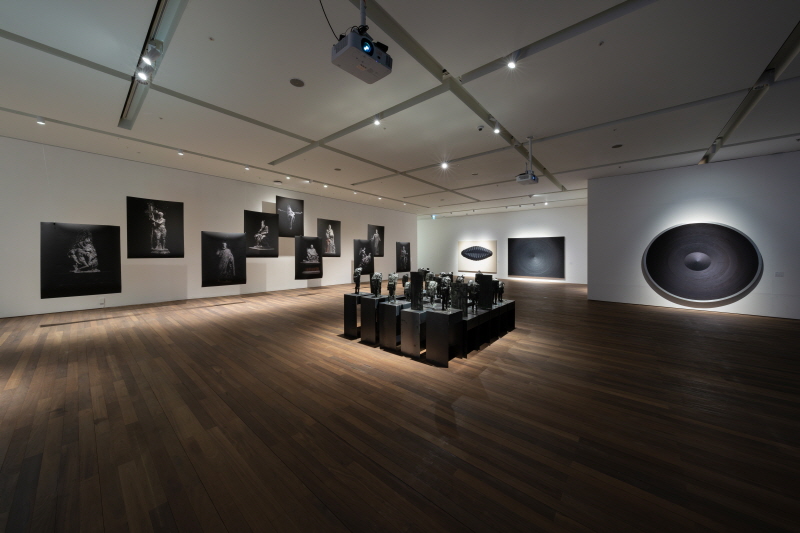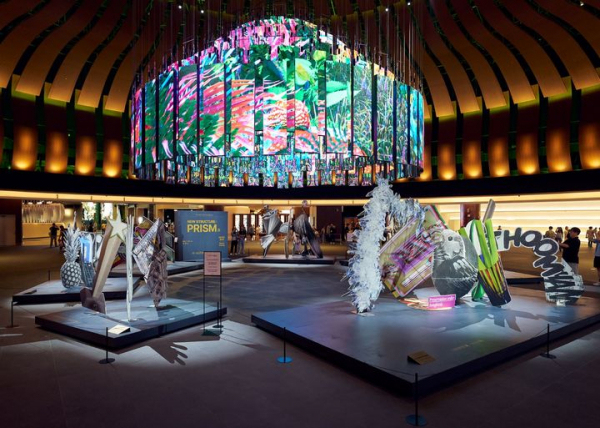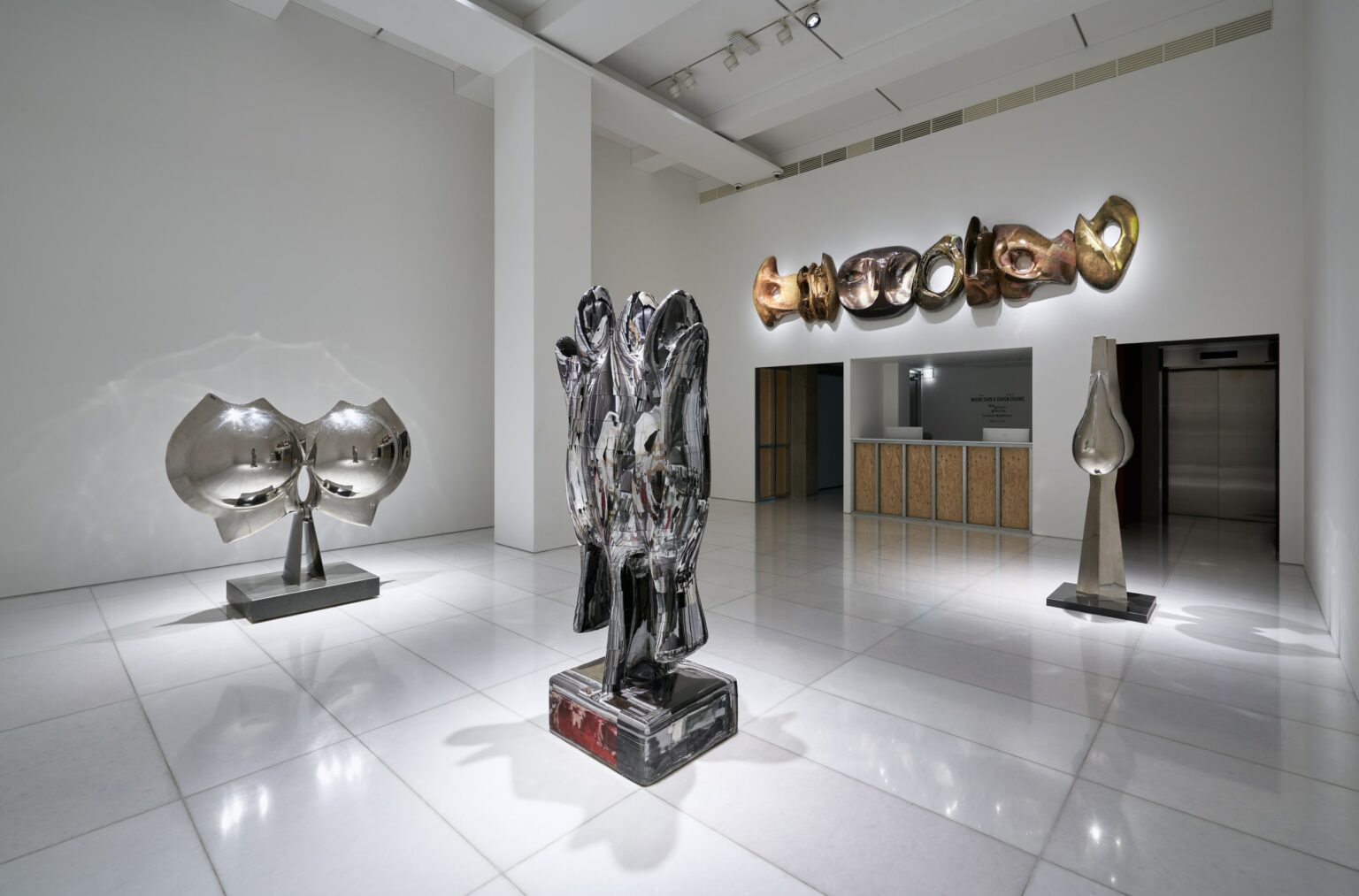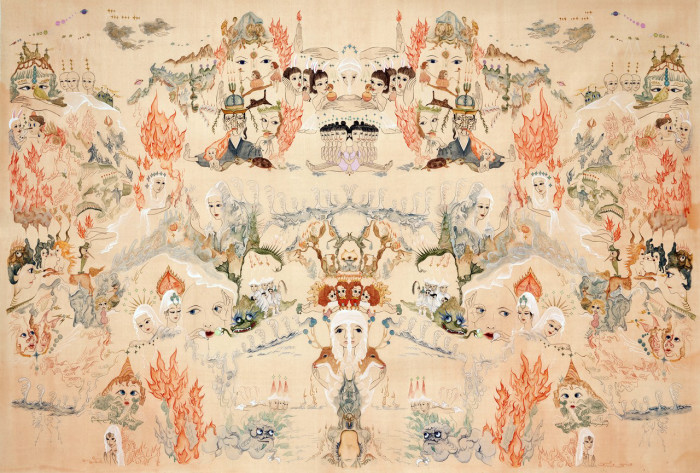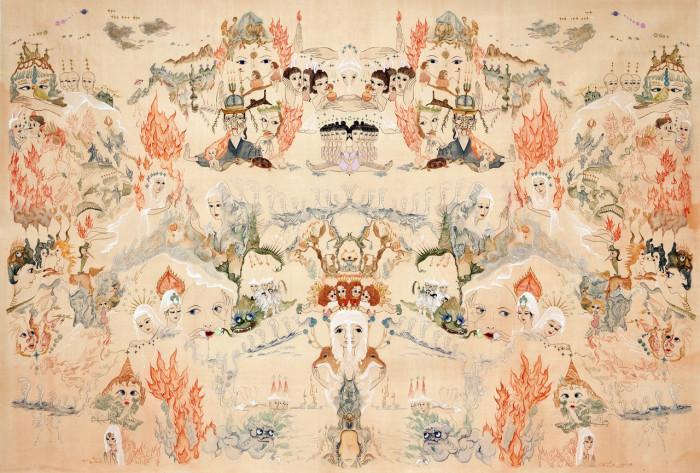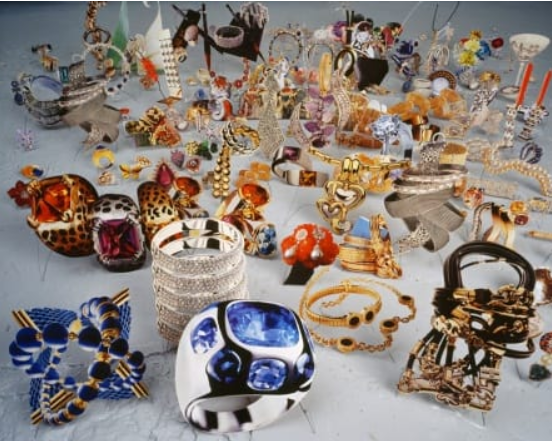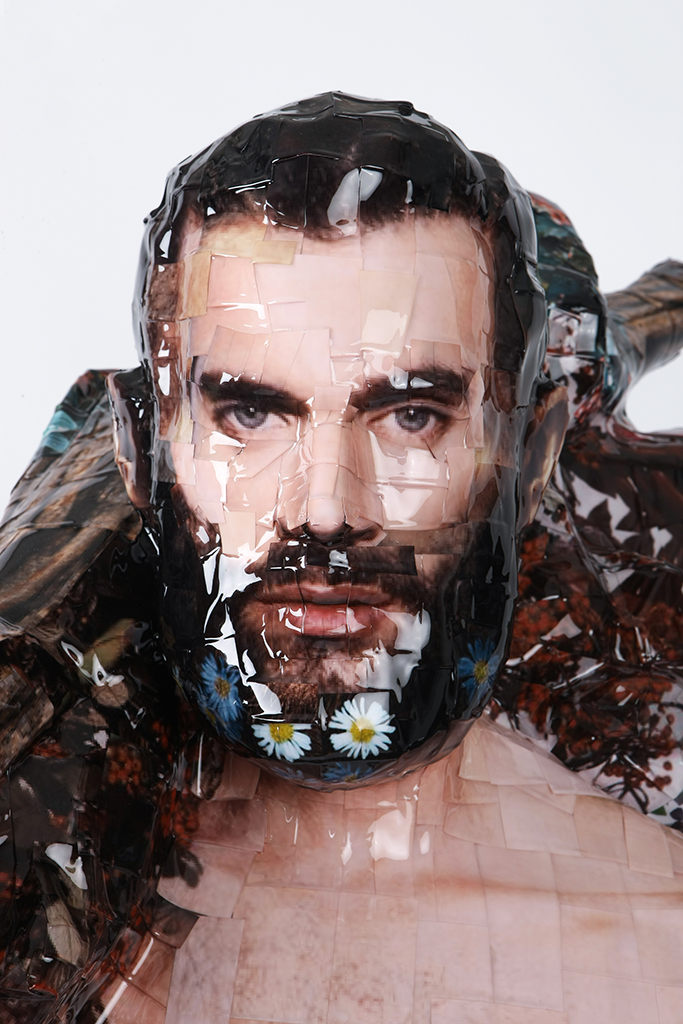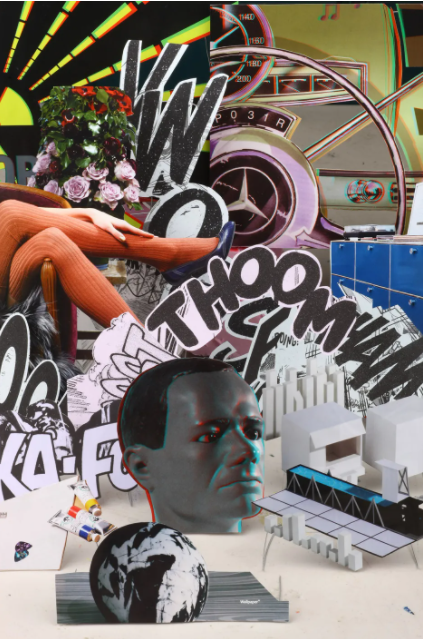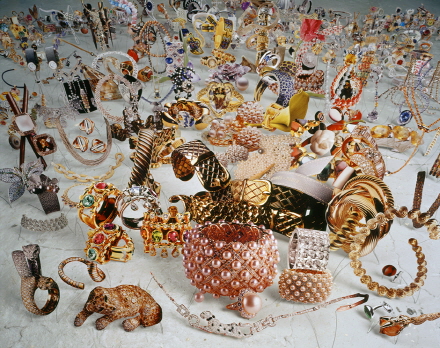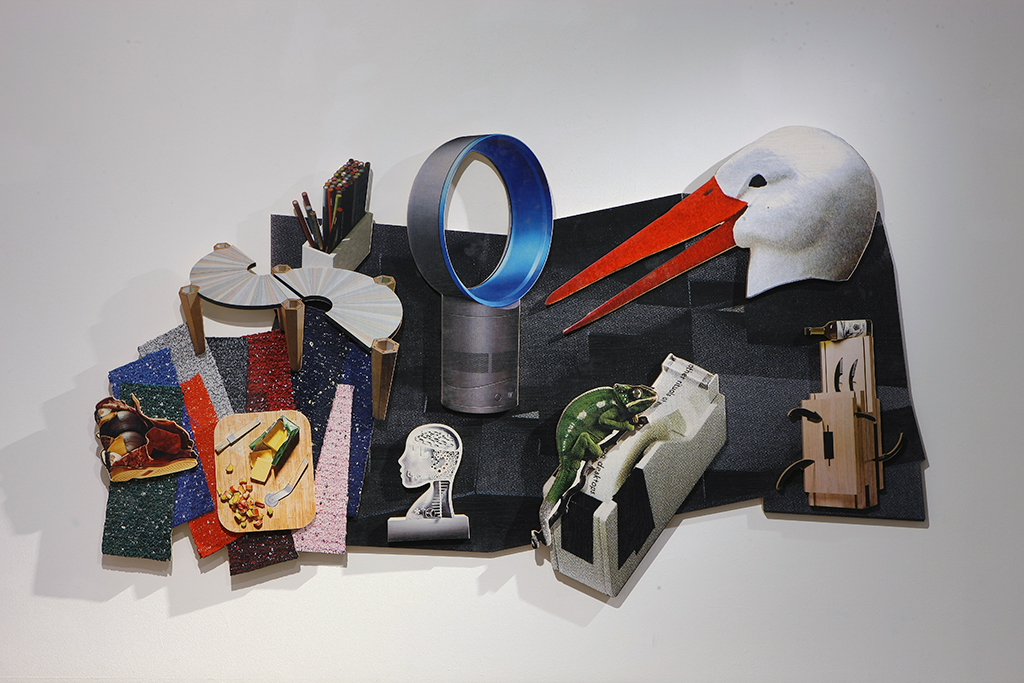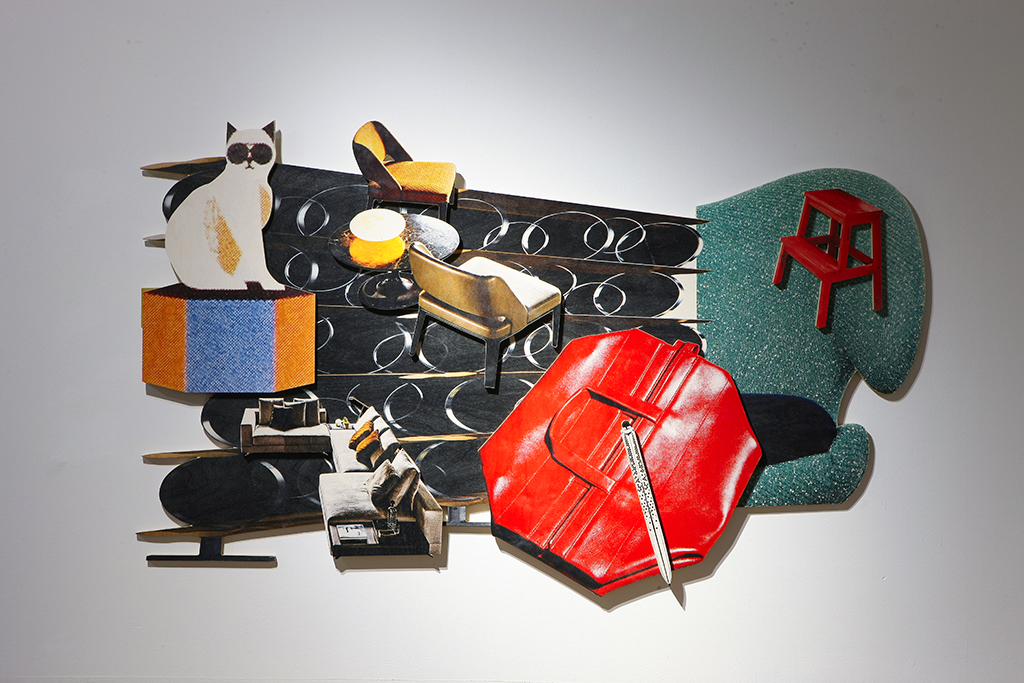1.
In general, Osang Gwon’s oeuvre consists largely of Deodorant Type, The Flat, and The Sclupture series. Started in beginning of 1998, Deodorant Type is the oldest, most acclaimed of Gwon’s art practice. In the so-called ‘photo-sculpture’, the artist takes photographs of a subject in many angles, prints them out, then cuts and pastes them onto the carved sculptures. This original and remarkable idea was an unparalleled case in contemporary of art history. Obviously, the idea didn’t just spring up one day; the masterpieces were born as a result of a comprehensive contemplation on contemporary art, attributes of camera, and formative language of sculpture.
Gwon’s very first work was a representation of a chisel used in woodworking. He expressed a sculptural tool made of hard metal and wood with delicate paper. Then he started to broaden his art practice by making heads, busts, torsos, and full-length portraits in that order[1]. He received official recognition from the press when he presented his work A Statement of 540 Pieces on Twins (1999) in the Vacuum-packed Exhibition at Alternative Space Pool in August of 1999. And when he from his university in February 2000, his debut in the art world was swift and sophisticated.
Gwon’s photo-sculptures are, literally, sculptures that use photographs. Photographs replicate 3-dimensional form into a 2-dimenional surface. As a form becomes flat, the actual subject cannot be transferred on the photograph in exactitude. In order to recover the vanished 3-dimensionality, Gwon puts together the countless number of photographs like ‘moldings’ and constructs a 3-dimensional form. While it seems like an ingenious way of supplementing the weakness in photography, his work actually roots from the assumption that photography cannot perfectly reproduce the subject from the beginning, and that it can actually distort the subject. Photograph just captures a part of something 3-dimensional into something flat through a mechanical eye. Although the captured part is something real, Gwon’s work can create something that’s completely different from the original subject when the photographs are connected and glued together. In other words, while each statement may be the truth, the result can vary in a thousand different ways according to how the statements are put together.
In addition, attributes of photography include magnification, reduction and reproduction. Like in A Statement of 540 Pieces on Twins, Gwon produced two works from one source. A mysterious work was produced, cleverly blending the real and virtual.
Gwon held his first solo exhibition in June 2001. The title of the exhibition was Deodorant Type, and he presented photo-sculptures of various subjects such as aliens, cars, dogs with two heads, twins and boulders. Gwon explained that what gave an overall explanation of the whole exhibition space was the Chinese Garden (2001) a portrayal of a boulder, a large work measured 2m in height and 1.5m in length. Instead of putting the boulder in the main space (which measuring about 330㎡), Gwon put it in a small space in the back, and placed nearby a woman in white gown holding a telescope, standing on a jagged boulder[2]. Gwon presented a Damas automobile, aliens, intertwined twins, two dogs, and jagged boulders in the main space.
“There are often boulders in Japanese gardens. I believe that those boulders are amazing sculptural elements. Boulders can be a mountain, and what surrounds them can be the ocean. They’re quite symbolic. When constructing an exhibition, and filling up an empty space, one can install many works in the exhibition space. But when a small boulder is placed in a certain point like a piece in a game of Checkers, it can function as the center even though it isn’t the center. It can speak for the whole, as it creates an accent in the space[3].” (Excerpt from an interview with the artist, July 2012)
Deodorant in the title Deodorant Type is a product that alleviates human odor, especially from the armpit. Instead of essentially eliminating the source of the odor, a deodorant lightly cover the unpleasant smell so that people cannot smell it. This in many ways has similarities with the attributes of photo-sculpture. While Gwon captures the subject with the medium of photography, the captured image becomes mixed, creating something slightly different from the original subject[4].
2.
Gwon presented The Flat series in 2003 and the Sculptural Series in 2005 successively. Weighing as little as 10g to as much as 2tons, the diversity in Gwon’s works makes it hard for people to believe that they come from the same artist.
As widely-acclaimed, Gwon cuts out advertisement images such as watches, makeup and jewelry, affixes wire behind them and props them up on the floor. He doesn’t let these sculptures — that are so light that they can be blown away by the wind — stand in the world alone; he installs a great number of them, photographs the installation and prints it. Going through a series of twists from 3-dimensional (product) to flat (image on the magazine), to 3-dimensional (sculpture) and again to flat (photograph), The Flat series has a clear association with Deodorant Type which skillfully combines the flatness of photography with 3-dimensionality of sculpture.
When one looks closely at the eyes, nose, lips and ears in the photo-sculptures, one can assume that the work is actually rather flat, even though such aspects could have be rendered more 3-dimensionally. On the other hand, the three-dimensionality of the simple sculptures in The Flat series can be detected upon a closer inspection. Even though it would’ve been easy for Gwon to have completely concealed the wire that pokes out behind the paper sculptures in a sneaky way, the glimpses of wire reminds the viewer that the paper sculptures are standing on the ground, and that they are strictly sculptural structures.
The most notable work from The Sculpture series is The Sculpture II (2005), which is a cast of the super car Lamborghini Murcielago in bronze with oil paint on its surface. Without ever having seen the actual car, Gwon created the work by collecting information about it from the internet, publications, magazines and mini-cars. In the sense that the work is a combination of information gathered from various mediums, this work, which is like a collection of statements, has a clear point of association with the methodology of Deodorant Type series. The process of making a plaster mold of the original form is similar to creating the negative in film. Similarly, the process of putting together the plaster mold and creating the form of the original is analogous to the printing process in photography.
While some already knew that bronze was the main material of The Sculpture II because its production process became a hot issue, it’s actually hard to tell what the material is as the surface is coated with thick orange paint (It could just as well have been color painted on plastic). However, the audience realizes that the work is made of bronze upon touching the work, and at that moment, they come to realize that the work is very heavy.
The Sculpture Ⅷ – Still life (2006) was the work that followed. The Sculpture series started to display many colors. Various objects are placed on a large pedestal in this all-in-one work portraying a studio. While Gwon had drawn a metaphor to pedestals through a boulder in A Statement of 420 Pieces on Twins, he has rarely used pedestals until then, nor installed anything on the floor to prop up his sculptural works[5]. Then all of a sudden, Gwon pays sharp attention to pedestals, because he realizes that there is something quite substantially significant in the attributes of the pedestal.
Deodorant Type series is met with changes in early 2000. In his solo exhibition in 2006 which presented the two series of works stated above, Gwon hybridized his Deodorant Type with Auguste Rodin’s ideas. Gwon presented a total of 5 photo-sculptures with Rodin’s The Burghers of Calais (1889) in mind. All figures in The Burghers of Calais are tied to a rope, are unable to resist. The figures are naked in Gwon’s Red Sun (2005-06) and Nobody (2005-06), a figure with his all portray a moment of hands in his coat in Gaze Motion (2005) and is holding plastic bags with both hands in Error (2005-06). They are all temporarily defenseless because both arms of the figures are not free.
The male figure in Step (2005-06) is stepping on a pedestal. The pedestal is the same size as the pedestal for The Burghers of Calais. Rodin is known to be the first artist in sculpture history to use a low pedestal. The model in Step comfortably has his one foot on the pedestal as if to be climbing stairs. The female figure in Slip Slider (2006-07) is always installed fallen off the pedestal. Most solitary sculpture works, except for reliefs or sculptures used as a subordinate element of architecture are usually traditionally placed vertically on the pedestal. Gwon is the only artist who can imagine such an interesting idea of a sculpture lying down horizontally on the floor, off the pedestal.
Then in June 2008, Gwon had his solo exhibition in Manchester, UK. While in Manchester for the Asian Triennial Manchester and an artist residency program, Manchester Museum of Art offered Gwon to host his solo exhibition.
Gwon remarked that the park was one of the things that impressed him most profoundly while he was staying in Manchester. Commonly in parks in Europe, there is a small square, and a figure or equestrian statue. Gwon ideologically transferred the park with a sculpture in it into the exhibition. The exhibition space in Manchester Museum of Art has quite a high in ceiling, measuring over 6m in height. Had Gwon simply spread the photo-sculptures in the space, the high ceiling space would have been overwhelming and the exhibition would’ve ended up in dull composition.
First, Gwon placed two low and wide pedestals that simplified the square in the middle of the exhibition space, and then arranged the photo-sculptures throughout the exhibition space. Each of the photo-sculptures was placed on its own pedestal which ranges in size with some soaring high and some ordinary. Suggesting an equestrian sculpture, Manchester Mounted Police (2008) looked over the whole exhibition space, with Pieta (2007) on its opposite side. The exhibition also presented figures such as a figure leaning on the pedestal, a figure that has fallen next to the pedestal, and a figure standing showing both of his hands, etc. In addition, the two large body of works Limbo Garden and Garden are stationed side by side. The exhibition weaved together sculptures, people and forest through photo-sculpture, and the visitors in the space added a layer of complexity to the exhibition.
Gwon added dynamics in height through the pedestals and postures. Furthermore, he installed a shelf in one wall like an alcove in the architecture, and placed photo-sculptures in it[6].
Gwon works through countless drawings and notes in order to create one work. However, finishing a work doesn’t mean that the work is completed. In the process of conceptual diagram which works out the relationship between his works, he considers the relationship between works in terms of their narrative or form, segmentalizing them or lining them up in order. Through this process, Gwon aspires to reclaim the missing elements in his work and find directivity in the future oeuvre, while forming multi-layered organic network of meaning in his art practice by figuring out the definite relationship between individual works.
3.
At around 2010, Gwon’s new series of work unfolds a new tendency. As the inherent element and characteristic in each series affect other series, each of the series is transformed remarkably.
The series that showed the biggest change in terms of form is The Flat series. In Gwon’s solo exhibition in 2011, there was the image of the monthly magazine Wallpaper in The Flat series. A magazine about architecture, fashion, travel, design and art, Wallpaper is a global magazine which presents the world’s hottest objects and scenes at the time of publication. Gwon usually makes one work using images from one volume of magazine. For example, 2005 June (2010) is composed of images only from the June 2005 volume of a magazine. Consequently, a motley collection of objects from architecture to design objects and graphic images appear in one image, presenting an open and sensational surface composition made of a patchwork of objects. Also, the wire which poked out shyly here and there in The Flat series now started to boldly present itself. The function of the wire had expanded, from not only propping up the paper images, to serving a sculptural purpose which produces a linear flow in the composition. The Flat series takes on a more experimental form in Gwon’s 2012 solo exhibition. In 2009, July (Head) (2012)[7], Gwon tests the sense of volume in 2-dimensionality by closing up on objects to the point where halftone dots are visible. He also accentuates on visual rhyme in 2011, December (Vase) (2012)[8] by arranging a repetition of objects of same size into different sizes, and in 2011, February (Prize) (2012) by focusing on an arrangement of similar shapes.
The Sculpture series was the highlight of his solo exhibition in Seoul in 2010. All five works in the exhibition portrayed motorbikes, in the shape of a torso with handles and wheels eliminated[9]. In art history, the concept of torso came about in the 19th century through Rodin. Before Rodin, the torso was seen as an unstable body, and the common convention was that it is difficult for the torso by itself to have any kind of aesthetic value. However, Rodin produced torsos in his conviction that the unstable form can activate the imagination much more than the completed form can.
What catches the attention in the new body of works colored in brilliant colors is a peculiar-looking pedestal with wheels. Used as a potter’s wheel, this pedestal is a tool that’s used in the production process. The sense of volume can hardly be felt in the pedestal itself as the metals have been connected like wire rod, consequently greatly maximizing the torso’s sense of volume. Also, the surfaces of Gwon’s torsos are rather uneven. As the painter suggests the spirit of the painter through oil paint and the particular brushwork, Gwon also aspired towards contemporary sculpture that holds the touch of the sculptor’s spirit. Although he didn’t intend to encase the real spirit of the sculptor in the work, Gwon reflected on the peculiarity of sculpture and its charms that completely fascinate him.
The Flat and The Sculpture series focus on still objects. In general, these still objects are great objects that represent the times. Gwon made Bugatti Veyron, one of the three supercars in 2005, which also appears later on in The Flat series, in 2009, September (2011). A material for The Sculpture series had been used again for The Flat series.
In distinct contrast to the headless limbless torsos, the works that Gwon presented in Fashion into Art exhibition hosted by Vogue Korea were protective guards for the head and limbs. He regards these tools as a continuation of his The Sculpture series. The main point of this exhibition was that the artist and the designer work together as a team, and Gwon became a partner with the fashion designer Han Sang-Hyuck[10]. To combine a fashion show and a motorcycle race, Gwon installed a runway in the form of a motorcycle circuit. However, this was no ordinary runway. Reminiscent of pedestals, this runway was so narrow that it could barely support one person’s pathway, and it was dotted with severed parts, as well as stairs, balance beams and elevated passage throughout the runway.
Wearing clothes designed by Han, three fashion models wore motorcyclist’s protection gear (for knees[11], elbows, back and head) designed by Gwon. Gwon coated synthetic resin on ordinary protection gear and colored them, producing special protection equipment. The guards on model’s head, back, elbows and knees definitely looked thick, as if something had been accumulated in layers and produced a sense of volume. Then Gwon assigned the models to walk on the re-created runway. However, the models couldn’t perform their elegant catwalk like on an ordinary runway, as they had to climb up and down the stairs, take the elevated pass, and even get on their knees and crawl in some parts. The model high up on the stairs and the model crawling on the floor created a sharp contrast.
A major leap in photo-sculpture took place, marked by diversification in the method of production. Contrary to Gwon’s previous works in which the artist himself took photographs of models and objects and printed them out, Gwon’s work took a pivotal turn in 2011 when he started searching, downloading and printing out internet images and fixing them unto his structures. This method was first applied in Sherpa (2011), in which a hiker wearing a backpack stands with a goat and an owl on his shoulders. While exploring ways of attaching lumps on photo-sculptures, which is an idea that has always fascinated the artist, Gwon came to put on hiking gear and animals on the human body. Putting on lumps on sculptures takes on a much more developed form later on in his photo-sculptures in 2012[12]. Although Gwon’s method of searching for images online in Sherpa might seem unfamiliar, Gwon had already created the Lamborghini Murcielago through searching on the internet without ever having actually seen the real object.
The representative example of this process is Untitled (Hockney) (2012), which portrays the artist David Hockney. Never having met Hockney in real life, Gwon found various pictures of Hockney from his twenties until now, and assembled them. Therefore, one can discover in a closer look, quite a few parts that are awkward in shape and color. Gwon claimed that the most difficult part was Hockney’s back, because people don’t usually take photographs of peoples’ backs. Thinking about ways of finding a picture of Hockney’s back, Gwon came across an image of his back from a 70s documentary film about the artist, and captured it. As a result, one can see the clear trace of pixels in the back part.
The most interesting photo-sculptures in the solo exhibition this year were Ruby Nike Bape (2012) and Untitled (2012). Inspired by Baroque sculptures, figures of various sizes surround the main character in the original works of these sculptures. Thus the original Baroque sculptures are relatively complex in form, and it’s precisely this complex composition that prompted Gwon to choose these sculptures.
“Smaller parts make up the whole in Ruby Nike Bape and Untitled. For example, the ankle part is easily breakable in marble sculptures of one standing figure, so it has a structure in which fabric, trees, angels or children are stuck to the form to strengthen it. I thought of that as attaching a lump like a type of molding. Attaching a lump can make the composition more complex and thus makes the work more interesting in form and narrative, and I thought that in a way, such act itself is a sculptural one.” (Excerpt from an interview with the artist, July 2012)
Ruby Nike Bape is a take-off on Gian Lorenzo Bernini’s Aeneas, Anchises, and Ascanius (1618-1619). In the original work, the main hero Aeneas is leaving the war-ridden Troy with his son Ascanius, propping up Anchises, his father with a limp. Gwon replaced these three figures with three people that he knows. The small person symbolizing Ascanius is holding onto a bottle of engine oil, wearing a Ruby (brand name) helmet and wearing Nike clothes. The engine oil and helmet are elements connected to Gwon’s previous motorcycle works. In the original work, Anchises is covering the lower half of his body with fabric that’s like sheep fur. Interestingly in this fabric, there’s a part that mimics a face, with eyes, nose and teeth. Inspired by this, Gwon thought of putting in clothes that has an image of eyes and teeth. Hooded shirts that zip up to the top of the head to complete a shark face were recently very popular, and the originator of such hooded shirt was called Bape Shark Hoodie. In this work, the hooded shirt playfully portrays a shark’s eyes and teeth.
In front of this work is Untitled, which is based on the original work titled Apotheosis of Prince Eugene (1718-1721) by an Austrian sculptor Balthasar Permoser. This work was made for Prince Eugene of Savoy, the figure in the work. The prince was one of the most prominent soldiers in the modern history of Europe, and this sculpture is housed in his summer palace, Belvedere Palace.
Untitled came about when a collector in India asked Gwon to produce a work last year, and Gwon proposed that he would produce a photo-sculpture based on a work by Permoser. However, the collector wanted an Indian in the work. Gwon searched online for the national actor of India, and consequently came to feature Amitabh Bachchan as his model in the work. Gwon placed Bachchan in the center, with Miranda Kerr in front of him and Kanye West behind him. The figure that’s trampled underneath became a problem, because Gwon didn’t want to create political problems related to India’s caste system. Therefore, Gwon decided to put himself as the figure getting trampled over.
There is a round ball next to Bachchan’s face. Actually, this also appears in The Flat series, in 2011 October (3D) (2012). Gwon used images of ball-shaped marble and made the form. The angel in the original was replaced by a monkey, which also appeared in the photo-sculpture Volume (2011)[13].
3+
Gwon’s work is normally divided into Deodorant Type, The Flat, and The Sculpture series, probably because each series of work is so original and captivating. The Flat series and The Sculpture series seemed to cast a contrast when they were exhibited together in mid 2000. Since then, however, the sculptural language of each series started to deepen as each series started to affect each other and the gap between them has been continuously narrowing. In such process, it has become meaningless to distinguish the series, and even obsolete to forcefully attempt to classify the series.
Although this writing approached Gwon’s work in context of series for convenience sake, Gwon is an artist who escapes being categorized in a fixed and narrow sphere. He has always worked with an open attitude in an interdisciplinary style in sculpture, photography, installation and performance, going on further to broaden his practice working with other fields such as fashion and design. At times Gwon proposed groundbreaking ideas based on his unparalleled artistic sensibility, followed by a careful examination and reflection on his work. Gwon has always prioritized the practice of sculpture before individual art work, discourse of contemporary art before practice of sculpture, and meaning of artist before the discourse of contemporary art. Freely traversing different layers of thought including his work, practice of sculpture, discourse of contemporary art, and meaning of artist, Gwon’s exploration in these areas continues.
[1] Gwon even portrayed something as heavy as a boulder into a hollow photo-sculpture.
[2] The title of this work is A Statement of 420 Pieces on Twins (2001), and the woman and the boulder are not separable. The boulder also functions as a pedestal.
[3] The boulders of various sizes were used as sculptural aspects in the exhibition. Woks that followed, such as Hyde Park (2003) and Limbo Garden (2007) where a figure has his head in the bushes, and Garden (2007) in which a figure is buried by a pile of clothes, are works of same context.
[4] Gwon created the new term ‘Deodorant Type’, as if it were a method that already existed in history of photographic technology, such as Ambrotype and Daguerreotype.
[5] Gwon sees things that can support itself on the ground as sculpture in the wide sense of the word. Therefore, the simple sculptures in The Flat series are definitely sculptures.
[6] After this point, height in work installation becomes an important issue for Gwon. For example, each photo-sculpture and pedestal of the 5 human busts and 4 animal heads in Busts (2011-2012) differ in height measurement. Particularly, the exceptionally long neck of the ostrich is quite impressive.
[7] 2009, July (Head) portrays close-up shots of objects taken with a DSLR camera. A Large-format camera was used for the previous The Flat series.
[8] Images of the same object appear on the top and bottom of the surface in 2011, December (Vase). This is because the work uses all small images in the table of content in the magazine as well as the large images that follow.
[9] Gwon conceptualized The Sculpture series while he was an artist in residency at The National Museum of Contemporary Art’s The National Art Studio, Changdong in 2005. As the doorframe of his studio was only about 80cm in width, he created motorbikes, which was something that was as close to cars in design, but could also pass through the doorframe of his studio. The first motorcycle had handles and wheels, but they were damaged when the work was transported between studios. He had no choice but to get rid of the handles and the wheels, and the motorcycle became a torso in form. Greek sculptures of human also naturally had limbs at first. Many become a torso as time passed, as they were neglected or moved around and their limbs broke off.
[10] Gwon created Lithuania collaborating for the first time with a Japanese department store company in 2002. Since then, Gwon has collaborated with various people and companies including Nike, Fendi and the pop group Keane.
[11] Motorcyclist’s knee guard is called ‘knee slider’. Knee Slider (2007) portrays the knee guard, and Slip Slider, and Back Slider (2007-2008) are also derivatives of this term.
[12] Annapurna Mirror Ball (2011) is a work in same context, and the model is stepping on a mirror ball. This mirror ball was the first actual object to be used in Deodorant Type series.
[13] Unlike previous photo-sculptures, Untitled consists of excessive number of people and things, including not only four human figures but also a monkey, round ball, broom, a level, tree, and trumpet. Such tight composition brings to mind the compact object placement in The Flat series.



